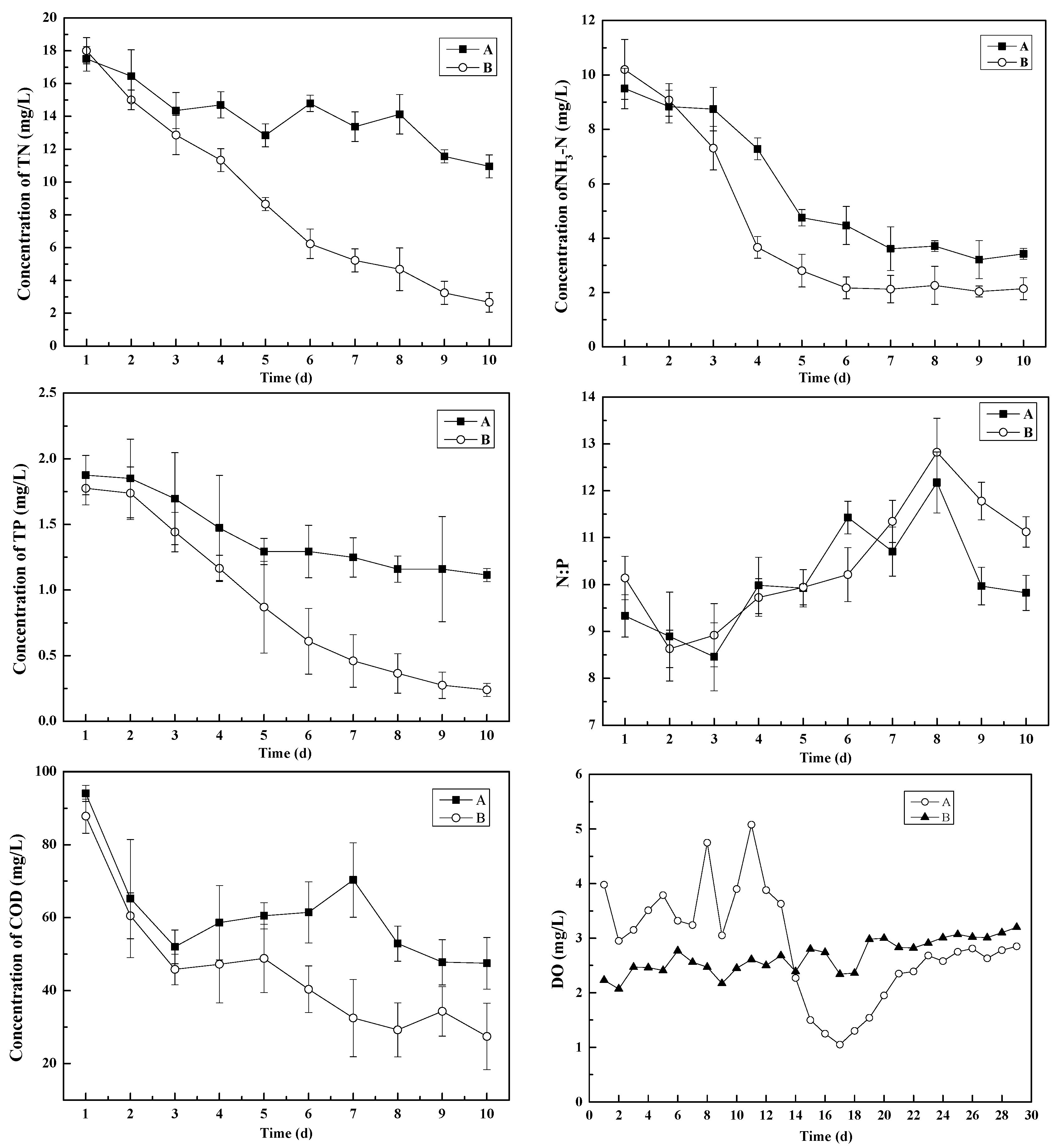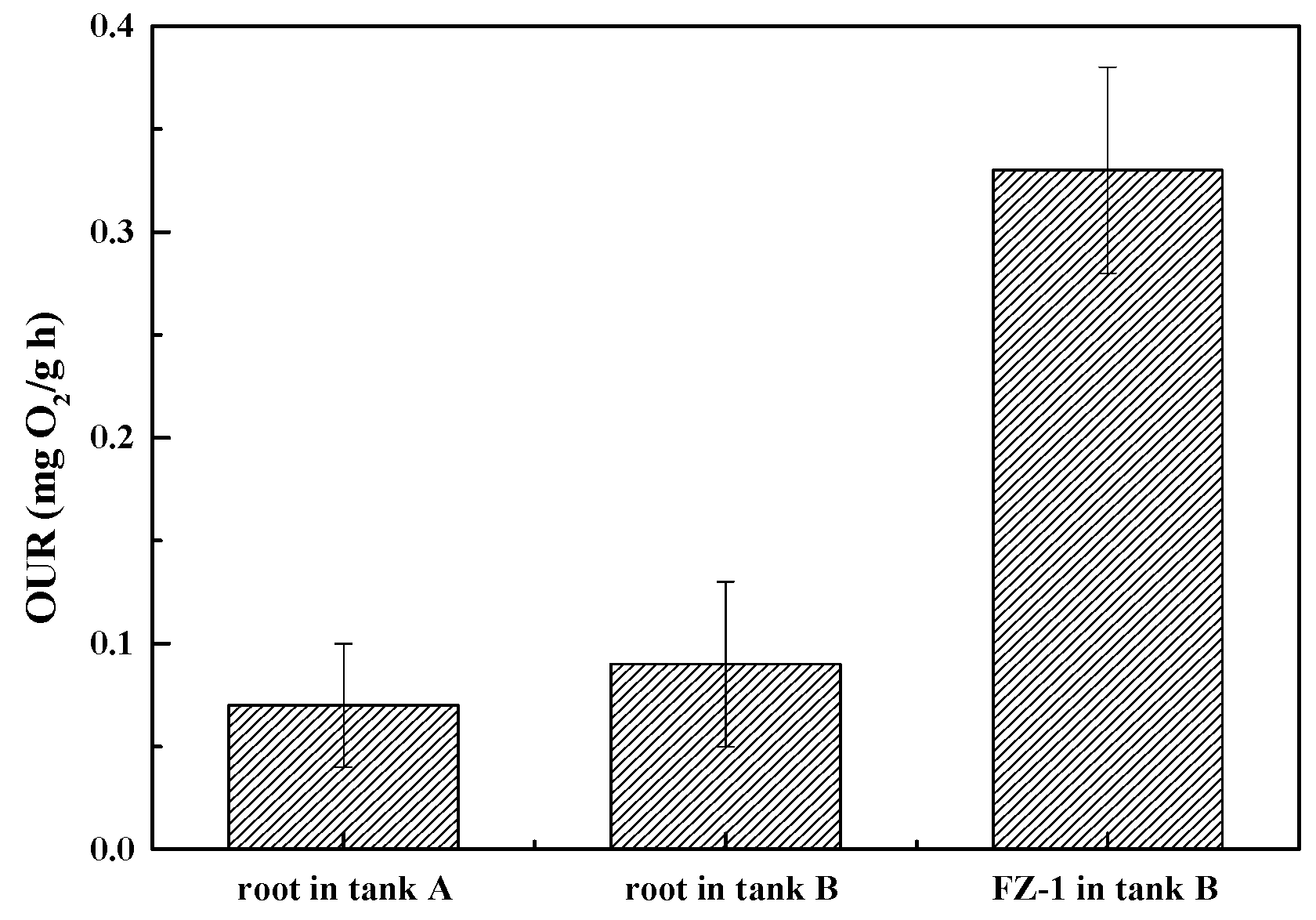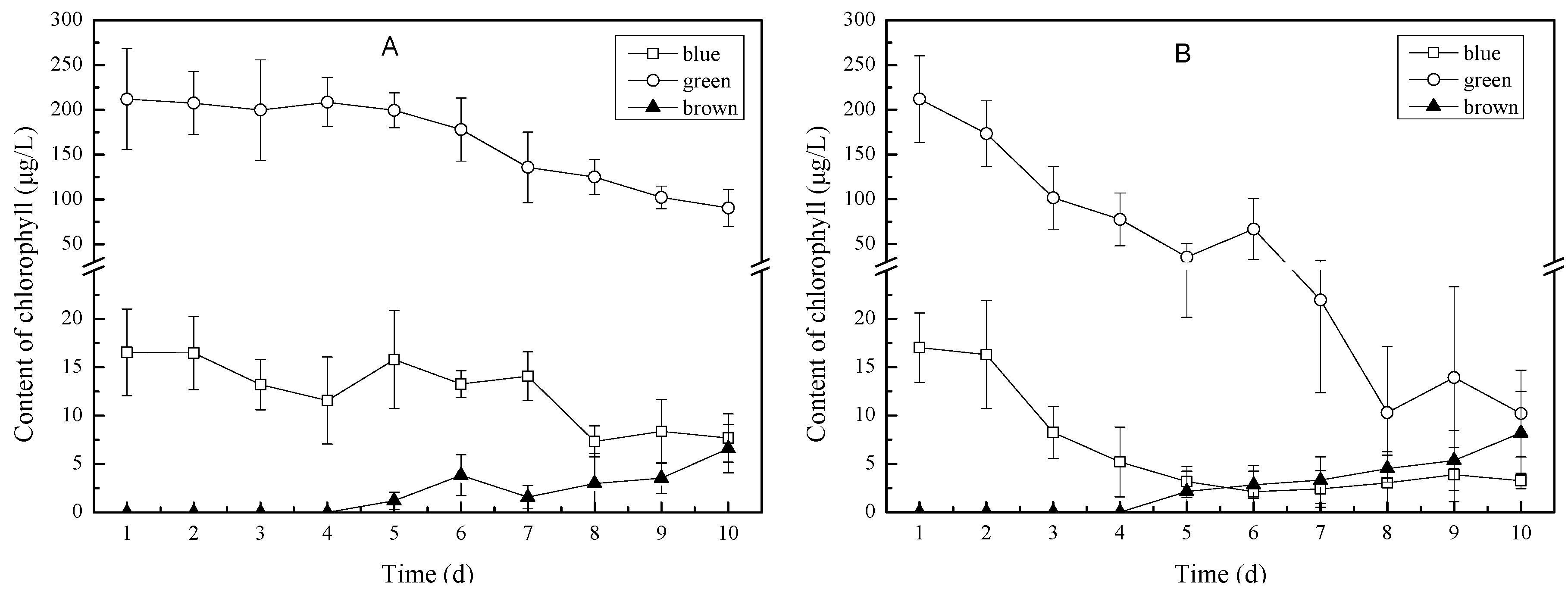An Enhanced System with Macrophytes and Polyurethane Sponge as an Eco-Technology for Restoring Eutrophic Water: A Pilot Test
Abstract
:1. Introduction
2. Materials and Methods
2.1. Study Area
2.2. Description of FBTS
2.3. Experimental Design
2.4. Sampling and Analysis
2.4.1. Water Qualities
2.4.2. Growth Characteristics of Canna
2.4.3. Measurement of Oxygen Uptake Rate (OUR)
2.4.4. Phytoplankton Community
2.5. Statistical Analysis
3. Results
3.1. Environmental Variables
3.2. Plant Growth
3.3. Oxygen Uptake Rate
3.4. Phytoplankton Assemblages and Correlation Analysis
4. Discussion
5. Conclusions
Author Contributions
Funding
Acknowledgments
Conflicts of Interest
References
- Suski, J.G.; Swan, C.M.; Salice, C.J.; Wahl, C.F. Effects of pond management on biodiversity patterns and community structure of zooplankton in urban environments. Sci. Total Environ. 2018, 619, 1441–1450. [Google Scholar] [CrossRef] [PubMed]
- Luo, X.; Li, X. Using the EFDC model to evaluate the risks of eutrophication in an urban constructed pond from different water supply strategies. Ecol. Model. 2018, 372, 1–11. [Google Scholar] [CrossRef]
- Waajen, G.W.; Faassen, E.J.; Lurling, M. Eutrophic urban ponds suffer from cyanobacterial blooms: Dutch examples. Environ. Sci. Pollut. Res. Int. 2014, 21, 9983–9994. [Google Scholar] [CrossRef] [PubMed]
- Guo, Y.; Liu, Y.; Zeng, G.; Hu, X.; Li, X.; Huang, D.; Liu, Y.; Yin, Y. A restoration-promoting integrated floating bed and its experimental performance in eutrophication remediation. J. Environ. Sci.-China 2014, 26, 1090–1098. [Google Scholar] [CrossRef]
- Mo, S.; Zhang, X.; Tang, Y.; Liu, Z.; Kettridge, N. Effects of snails, submerged plants and their coexistence on eutrophication in aquatic ecosystems. Knowl. Manag. Aquat. Ecosyst. 2017, 44. [Google Scholar] [CrossRef]
- Hu, Y.; He, F.; Ma, L.; Zhang, Y.; Wu, Z. Microbial nitrogen removal pathways in integrated vertical-flow constructed wetland systems. Bioresour. Technol. Rep. 2016, 207, 339–345. [Google Scholar] [CrossRef] [PubMed]
- Jones, T.G.; Willis, N.; Gough, R.; Freeman, C. An experimental use of floating treatment wetlands (FTWs) to reduce phytoplankton growth in freshwaters. Ecol. Eng. 2017, 99, 316–323. [Google Scholar] [CrossRef] [Green Version]
- Paerl, H.W.; Valdes, L.M.; Pinckney, J.L.; Piehler, M.F.; Dyble, J.; Moisander, P.H. Phytoplankton photopigments as indicators of estuarine and coastal eutrophication. BioScience 2003, 53, 953–964. [Google Scholar] [CrossRef]
- Zhang, X.I.A.; Xie, P.; Chen, F.; Li, S.; Qin, J. Driving forces shaping phytoplankton assemblages in two subtropical plateau lakes with contrasting trophic status. Freshw. Biol. 2007, 52, 1463–1475. [Google Scholar] [CrossRef]
- Cao, J.; Hou, Z.Y.; Li, Z.K.; Chu, Z.S.; Yang, P.P.; Zheng, B.H. Succession of phytoplankton functional groups and their driving factors in a subtropical plateau lake. Sci. Total Environ. 2018, 631–632, 1127–1137. [Google Scholar] [CrossRef]
- Çelekli, A.; Öztürk, B.; Kapı, M. Relationship between phytoplankton composition and environmental variables in an artificial pond. Algal Res. 2014, 5, 37–41. [Google Scholar] [CrossRef]
- Zhang, M.; Shi, X.; Yang, Z.; Yu, Y.; Shi, L.; Qin, B. Long-term dynamics and drivers of phytoplankton biomass in eutrophic Lake Taihu. Sci. Total Environ. 2018, 645, 876–886. [Google Scholar] [CrossRef] [PubMed]
- Leruste, A.; Malet, N.; Munaron, D.; Derolez, V.; Hatey, E.; Collos, Y.; De Wit, R.; Bec, B. First steps of ecological restoration in Mediterranean lagoons: Shifts in phytoplankton communities. Estuar. Coast. Shelf Sci. 2016, 180, 190–203. [Google Scholar] [CrossRef] [Green Version]
- Barot, S.; Lata, J.C.; Lacroix, G. Meeting the relational challenge of ecological engineering within ecological sciences. Ecol. Eng. 2012, 45, 13–23. [Google Scholar] [CrossRef]
- Kasprzak, P.; Gonsiorczyk, T.; Grossart, H.-P.; Hupfer, M.; Koschel, R.; Petzoldt, T.; Wauer, G. Restoration of a eutrophic hard-water lake by applying an optimised dosage of poly-aluminium chloride (PAC). Limnologica 2018, 70, 33–48. [Google Scholar] [CrossRef]
- Abed, S.N.; Almuktar, S.A.; Scholz, M. Remediation of synthetic greywater in mesocosm—Scale floating treatment wetlands. Ecol. Eng. 2017, 102, 303–319. [Google Scholar] [CrossRef]
- Fang, T.; Bao, S.; Sima, X.; Jiang, H.; Zhu, W.; Tang, W. Study on the application of integrated eco-engineering in purifying eutrophic river waters. Ecol. Eng. 2016, 94, 320–328. [Google Scholar] [CrossRef]
- Li, X.-N.; Song, H.-L.; Li, W.; Lu, X.-W.; Nishimura, O. An integrated ecological floating-bed employing plant, freshwater clam and biofilm carrier for purification of eutrophic water. Ecol. Eng. 2010, 36, 382–390. [Google Scholar] [CrossRef]
- Fontanarrosa, M.S.; Allende, L.; Rennella, A.M.; Boveri, M.B.; Sinistro, R. A novel device with macrophytes and bio balls as a rehabilitation tool for small eutrophic urban ponds: A mesocosm approximation. Limnologica 2019, 74, 61–72. [Google Scholar] [CrossRef]
- Chang, Y.-H.; Ku, C.-R.; Yeh, N. Solar powered artificial floating island for landscape ecology and water quality improvement. Ecol. Eng. 2014, 69, 8–16. [Google Scholar] [CrossRef]
- Li, L.; Yang, Y.; Tam, N.F.Y.; Yang, L.; Mei, X.-Q.; Yang, F.-J. Growth characteristics of six wetland plants and their influences on domestic wastewater treatment efficiency. Ecol. Eng. 2013, 60, 382–392. [Google Scholar] [CrossRef]
- The State Environmental Protection Administration The Water and Wastewater Monitoring Analysis Method Editorial Board. Water and Wastewater Monitoring Analysis Method, 4th ed. (enlarged edition); China Environmental Science Press: Beijing, China, 2009. [Google Scholar]
- Garcia-Ochoa, F.; Gomez, E.; Santos, V.E.; Merchuk, J.C. Oxygen uptake rate in microbial processes: An overview. Biochem. Eng. J. 2010, 49, 289–307. [Google Scholar] [CrossRef]
- Padisak, J.; Crossetti, L.O.; Naselli-Flores, L. Use and misuse in the application of the phytoplankton functional classification: A critical review with updates. Hydrobiologia 2009, 621, 1–19. [Google Scholar] [CrossRef]
- Reynolds, C.S.; Huszar, V.; Kruk, C.; Naselliflores, L.; Melo, S. Towards a functional classification of the freshwater phytoplankton. J. Plankton Res. 2002, 24, 417–428. [Google Scholar] [CrossRef]
- Gogina, E.; Gulshin, I. Simultaneous Nitrification and Denitrification with Low Dissolved Oxygen Level and C/N ratio. Procedia Eng. 2016, 153, 189–194. [Google Scholar] [CrossRef] [Green Version]
- Yeh, N.; Yeh, P.; Chang, Y.-H. Artificial floating islands for environmental improvement. Renew. Sustain. Energy Rev. 2015, 47, 616–622. [Google Scholar] [CrossRef]
- Van de Moortel, A. Use of floating macrophyte mats for treatment of CSOs. In Proceedings of the 11th international conference on urban drainage, Edinburgh, UK, 31 August–5 September 2008. [Google Scholar]
- Pi, N.; Ng, J.Z.; Kelly, B.C. Uptake and elimination kinetics of perfluoroalkyl substances in submerged and free-floating aquatic macrophytes: Results of mesocosm experiments with Echinodorus horemanii and Eichhornia crassipes. Water Res. 2017, 117, 167–174. [Google Scholar] [CrossRef]
- Sun, L.; Liu, Y.; Jin, H. Nitrogen removal from polluted river by enhanced floating bed grown canna. Ecol. Eng. 2009, 35, 135–140. [Google Scholar] [CrossRef]
- Luo, Y.; Guo, W.; Ngo, H.H.; Nghiem, L.D.; Hai, F.I.; Kang, J.; Xia, S.; Zhang, Z.; Price, W.E. Removal and fate of micropollutants in a sponge-based moving bed bioreactor. Bioresour. Technol. 2014, 159, 311–319. [Google Scholar] [CrossRef]
- Zhang, X.; Chen, X.; Zhang, C.; Wen, H.; Guo, W.; Ngo, H.H. Effect of filling fraction on the performance of sponge-based moving bed biofilm reactor. Bioresour. Technol. 2016, 219, 762–767. [Google Scholar] [CrossRef]
- Song, Z.; Zhang, X.; Ngo, H.H.; Guo, W.; Song, P.; Zhang, Y.; Wen, H.; Guo, J. Zeolite powder based polyurethane sponges as biocarriers in moving bed biofilm reactor for improving nitrogen removal of municipal wastewater. Sci. Total Environ. 2019, 651, 1078–1086. [Google Scholar] [CrossRef] [PubMed]
- Takamura, N.; Otsuk, A.; Aizaki, M.; Nojiri, Y. Phytoplankton species shift accompanied by transition from nitrogen dependence to phosphorus dependence of primary production in lake Kasumigaura, Japan. Arch. Hydrobiol. 1992, 124, 129–148. [Google Scholar]
- Lv, J.; Wu, H.; Chen, M. Effects of nitrogen and phosphorus on phytoplankton composition and biomass in 15 subtropical, urban shallow lakes in Wuhan, China. Limnologica 2011, 41, 48–56. [Google Scholar] [CrossRef] [Green Version]
- Xie, L.; Xie, P.; Li, S.; Tang, H.; Liu, H. The low TN:TP ratio, a cause or a result of Microcystis blooms? Water Res. 2003, 37, 2073–2080. [Google Scholar] [CrossRef]
- Dodds, W.K.; Smith, V.H.; Lohman, K. Nitrogen and phosphorus relationships to benthic algal biomass in temperate streams. Can. J. Fish Aquat. Sci. 2002, 59, 865–874. [Google Scholar] [CrossRef] [Green Version]
- Cymbola, J.; Ogdahl, M.; Steinman, A.D. Phytoplankton response to light and internal phosphorus loading from sediment release. Freshw. Biol. 2008, 53, 2530–2542. [Google Scholar] [CrossRef]
- Vitense, K.; Hanson, M.A.; Herwig, B.R.; Zimmer, K.D.; Fieberg, J. Predicting total phosphorus levels as indicators for shallow lake management. Ecol. Indic. 2019, 96, 278–287. [Google Scholar] [CrossRef]
- Lockaby, B.G.; Walbridge, M.R. Southern Forested Wetlands: Ecology and Management; Messina, M.G., Connor, W.H., Eds.; CRC Press: Boca Raton, FL, USA, 1998; pp. 149–172. [Google Scholar]
- Bai, X.; Ye, Z.; Li, Y.; Yang, L.; Qu, Y.; Yang, X. Preparation and characterization of a novel macroporous immobilized micro-organism carrier. Biochem. Eng. J. 2010, 49, 264–270. [Google Scholar] [CrossRef]
- Lagus, A. Species-specific differences in phytoplankton responses to N and P enrichments and the N:P ratio in the Archipelago Sea, northern Baltic Sea. J. Plankton Res. 2004, 26, 779–798. [Google Scholar] [CrossRef] [Green Version]
- Lang, P.; Meis, S.; Prochazkova, L.; Carvalho, L.; Mackay, E.B.; Woods, H.J.; Pottie, J.; Milne, I.; Taylor, C.; Maberly, S.C.; et al. Phytoplankton community responses in a shallow lake following lanthanum-bentonite application. Water Res. 2016, 97, 55–68. [Google Scholar] [CrossRef] [Green Version]
- Su, Y.; Zhang, C.; Liu, J.; Weng, Y.; Li, H.; Zhang, D. Assessing the impacts of phosphorus inactive clay on phosphorus release control and phytoplankton community structure in eutrophic lakes. Environ. Pollut. 2016, 219, 620–630. [Google Scholar] [CrossRef] [PubMed] [Green Version]
- Carey, C.C.; Ibelings, B.W.; Hoffmann, E.P.; Hamilton, D.P.; Brookes, J.D. Eco-physiological adaptations that favour freshwater cyanobacteria in a changing climate. Water Res. 2012, 46, 1394–1407. [Google Scholar] [CrossRef] [PubMed]
- Cottingham, K.L.; Ewing, H.A.; Greer, M.L.; Carey, C.C.; Weathers, K.C. Cyanobacteria as biological drivers of lake nitrogen and phosphorus cycling. Ecosphere 2015, 6, art1. [Google Scholar] [CrossRef]
- Kozak, A.; Celewicz-Goldyn, S.; Kuczynska-Kippen, N. Cyanobacteria in small water bodies: The effect of habitat and catchment area conditions. Sci. Total Environ. 2019, 646, 1578–1587. [Google Scholar] [CrossRef] [PubMed]
- Špoljar, M.; Dražina, T.; Šargač, J.; Borojević, K.K.; Žutinić, P. Submerged macrophytes as a habitat for zooplankton development in two reservoirs of a flow-through system (Papuk Nature Park, Croatia). Ann. Limnol.-Int. J. Limnol. 2012, 48, 161–175. [Google Scholar] [CrossRef] [Green Version]
- Celewicz-Gołdyn, S. Influence of Ceratophyllum demersum L. on phytoplankton structure in a shallow eutrophic lake. Oceanol. Hydrobiol. St. 2010, 39. [Google Scholar] [CrossRef]
- Uggetti, E.; Hughes-Riley, T.; Morris, R.H.; Newton, M.I.; Trabi, C.L.; Hawes, P.; Puigagut, J.; Garcia, J. Intermittent aeration to improve wastewater treatment efficiency in pilot-scale constructed wetland. Sci. Total Environ. 2016, 559, 212–217. [Google Scholar] [CrossRef] [Green Version]
- He, Q.; Chen, L.; Zhang, S.; Wang, L.; Liang, J.; Xia, W.; Wang, H.; Zhou, J. Simultaneous nitrification, denitrification and phosphorus removal in aerobic granular sequencing batch reactors with high aeration intensity: Impact of aeration time. Bioresour. Technol. 2018, 263, 214–222. [Google Scholar] [CrossRef]
- Papush, L.; Danielsson, Å. Silicon in the marine environment: Dissolved silica trends in the Baltic Sea. Estuar. Coast. Shelf Sci. 2006, 67, 53–66. [Google Scholar] [CrossRef]
- Liu, B.; Cao, S. Asynchronous changes in trophic status of a lake and its watershed inferred from sedimentary diatoms of different habitats. Ecol. Indic. 2018, 90, 215–225. [Google Scholar] [CrossRef]
- Shan, M.J.; Wang, Y.Q.; Shen, X. Study on bioremediation of eutrophic lake. J. Environ. Sci. 2009, 21, S16–S18. [Google Scholar] [CrossRef]
- Zhu, K.X.; Bi, Y.H.; Hu, Z.Y. Responses of phytoplankton functional groups to the hydrologic regime in the Daning River, a tributary of Three Gorges Reservoir, China. Sci. Total Environ. 2013, 450, 169–177. [Google Scholar] [CrossRef] [PubMed]





| Index | Chl-a (μg/L) | COD (mg/L) | NH3-N (mg/L) | TN (mg/L) | TP (mg/L) |
|---|---|---|---|---|---|
| Min | 200 | 65.3 | 7.2 | 8.8 | 0.9 |
| Max | 305 | 97.8 | 18.8 | 21.0 | 1.7 |
| Average | 265 | 86.4 | 11.5 | 16.8 | 1.2 |
| Type | Appearance (mm) | Diameter (mm) | Specific Surface Area (m2/m3) | Material Density (g/cm3) | Open Porosity (%) |
|---|---|---|---|---|---|
| FZ-1 | 50 × 50 × 50 | 0.2–5.0 | ≥15000 | 1.0–1.15 | ≥99 |
| Tank | Root Biomass (g DW/m2) | Above-Water Biomass (g DW/m2) | Root Length (cm) |
|---|---|---|---|
| Tank A | 49.3 ± 3.4 | 279.0 ± 40.5 | 32.4 ± 2.9 |
| Tank B | 65.4 ± 4.6 | 345.6 ± 27.4 | 40.5 ± 3.4 |
| Phylum | Species | Abundance (×104 ind./L) | Biomass (mg/L) | Dominance Degree (Y) | FG | Habitat Characteristics |
|---|---|---|---|---|---|---|
| Pond S | ||||||
| Cyanophyta | Microcystis flosaquae | 3456 | 1.73 | 0.860 | M | Eutrophic to hypertrophic, small to medium-sized lakes |
| Cyanophyta | Microcystis marginata | 307 | 0.15 | 0.076 | M | |
| Tank A | ||||||
| Chlorophyta | Staurastrum pingue | 630 | 3.15 | 0.509 | P | Similar to that of codon N (continuous or semi-continuous mixed layer) but at higher trophic states |
| Cyanophyta | Microcystis marginata | 499 | 0.25 | 0.403 | M | Eutrophic to hypertrophic, small to medium-sized lakes |
| Chlorophyta | Tetraedron tumidulum | 29 | 0.06 | 0.023 | J | Shallow, mixed, highly enriched systems |
| Tank B | ||||||
| Cyanophyta | Microcystis marginata | 77 | 0.04 | 0.325 | M | Eutrophic to hypertrophic, small to medium-sized lakes |
| Cyanophyta | Microcystis flosaquae | 38 | 0.02 | 0.162 | M | |
| Bacillariophyta | Cyclotella meneghiniana | 12 | 0.96 | 0.065 | C | Eutrophic small- and medium-sized lakes with species sensitive to the onset of stratification |
| Bacillariophyta | Melosira granulata | 7 | 0.22 | 0.030 | P | Similar to that of codon N (continuous or semi-continuous mixed layer) but at higher trophic states |
| Pyrrophyta | Peridinium bipes | 11 | 0.12 | 0.046 | LO | Deep and shallow, oligo to eutrophic, medium to large lakes |
| Chlorophyta | Staurastrum pingue | 24 | 0.12 | 0.102 | N | Continuous or semi-continuous mixed layer |
| Chlorophyta | Oocystis elliptica | 10 | 0.10 | 0.041 | F | Clear, deeply mixed mesotrophic-eutrophic lakes |
| Chlorophyta | Chlorella pyrenoidosa | 7 | 0.01 | 0.030 | X1 | Shallow, eutrophic-hypertrophic environments |
| Index | TN | TP | NH3-N | COD | Total Chlorophyll | Green | Blue | Brown |
|---|---|---|---|---|---|---|---|---|
| N:P ratio | −0.558 * | −0.718 ** | −0.681 ** | −0.426 | −0.543 * | −0.522 * | −0.554 * | 0.624 ** |
| TN | 0.972 ** | 0.826 ** | 0.877 ** | 0.926 ** | 0.879 ** | 0.927 ** | −0.795 ** | |
| TP | 0.898 ** | 0.836 ** | 0.920 ** | 0.884 ** | 0.919 ** | −0.828 ** | ||
| NH3-N | 0.751 ** | 0.835 ** | 0.826 ** | 0.837 ** | −0.764 ** | |||
| COD | 0.843 ** | 0.860 ** | 0.839 ** | −0.671 ** | ||||
| Total chlorophyll | 0.954 ** | 0.994 ** | −0.712 ** | |||||
| Green | 0.935 ** | −0.640 ** | ||||||
| Blue | −0.729 ** |
© 2019 by the authors. Licensee MDPI, Basel, Switzerland. This article is an open access article distributed under the terms and conditions of the Creative Commons Attribution (CC BY) license (http://creativecommons.org/licenses/by/4.0/).
Share and Cite
Wang, Y.; Yin, X.; Cai, Y.; Yang, Z. An Enhanced System with Macrophytes and Polyurethane Sponge as an Eco-Technology for Restoring Eutrophic Water: A Pilot Test. Water 2019, 11, 1828. https://doi.org/10.3390/w11091828
Wang Y, Yin X, Cai Y, Yang Z. An Enhanced System with Macrophytes and Polyurethane Sponge as an Eco-Technology for Restoring Eutrophic Water: A Pilot Test. Water. 2019; 11(9):1828. https://doi.org/10.3390/w11091828
Chicago/Turabian StyleWang, Yijie, Xinan Yin, Yanpeng Cai, and Zhifeng Yang. 2019. "An Enhanced System with Macrophytes and Polyurethane Sponge as an Eco-Technology for Restoring Eutrophic Water: A Pilot Test" Water 11, no. 9: 1828. https://doi.org/10.3390/w11091828
APA StyleWang, Y., Yin, X., Cai, Y., & Yang, Z. (2019). An Enhanced System with Macrophytes and Polyurethane Sponge as an Eco-Technology for Restoring Eutrophic Water: A Pilot Test. Water, 11(9), 1828. https://doi.org/10.3390/w11091828





